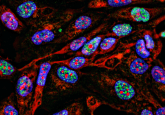New digital–analog microfluidic device developed for rapid and sensitive diagnostics

Researchers at École Polytechnique Federale De Lausanne (EPFL, Switzerland) have developed a low-cost and portable microfluidic diagnostic device. As it requires no bulky equipment it is suited for use in remote and resource-limited environments, which often require diagnostic equipment that functions away from hospitals. The device developed by EPFL has successfully tested Ebola and can be used to detect many other diseases.
This device was developed by Sebastian Maerkl and his team in the Laboratory of Biological Network Characterization at EPFL and their developments were recently reported online in the journal ACS Nano.
In recent years, microfluidic devices have demonstrated excellent potential in diagnostics and are able to detect various disease biomarkers in small quantities of blood. Maerkl’s device is portable, battery powered and fully self-sustaining. It is able to operate seamlessly with affordable microscopes, enabling high levels of diagnostic accuracy and biomarker detection. The device can quantify up to 16 biomarkers in blood sample of 5μL.
The device utilizes both analog and digital detection mechanisms; this enables the device to offset the limitations of each mechanism that are observed when they are used individually. The simultaneous use of analog and digital detection mechanisms means that blood drops can be analyzed in shorter time frames and this could aid earlier diagnoses and the rapid determination of disease stage. Initial testing has been carried out on samples containing anti-Ebola antibodies and it is hoped that the device could operate with a large number of other protein biomarkers and molecules.
A further benefit of the new device is that blood samples can be directly loaded onto the device and perform on-chip biomarker quantitation without requiring any sample pre-treatment. “For researchers, it is quite interesting to be able to avoid having to separate the blood,” commented Francesco Piraino, the article’s lead author.
“The platform will lead the development of new kinds of tests to meet the increasing demand for on-site diagnostic testing. It will prove very useful for medical staff working in resource-limited regions.” Piraino continued.
Source: A portable device for rapid and highly sensitive diagnostics




